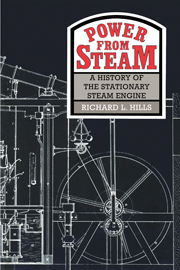Book contents
- Frontmatter
- Contents
- Preface
- Acknowledgements
- List of figures
- List of tables
- 1 The noblest machine
- 2 The impellent force of fire
- 3 Common old smoaking engines
- 4 The economy of power
- 5 The devil of rotations
- 6 Such unbounded power
- 7 Good servants but bad masters
- 8 An uncultivated field
- 9 The new theory of heat
- 10 The internal operation of the machine
- 11 Such absolute smoothness
- 12 Twinkle twinkle little arc
- 13 The drive for efficiency
- 14 An economical source of motive power
- 15 The most economical mode of obtaining power
- Notes
- Bibliography
- Index
12 - Twinkle twinkle little arc
Steam engines for generating electricity (1880–1900)
Published online by Cambridge University Press: 01 June 2011
- Frontmatter
- Contents
- Preface
- Acknowledgements
- List of figures
- List of tables
- 1 The noblest machine
- 2 The impellent force of fire
- 3 Common old smoaking engines
- 4 The economy of power
- 5 The devil of rotations
- 6 Such unbounded power
- 7 Good servants but bad masters
- 8 An uncultivated field
- 9 The new theory of heat
- 10 The internal operation of the machine
- 11 Such absolute smoothness
- 12 Twinkle twinkle little arc
- 13 The drive for efficiency
- 14 An economical source of motive power
- 15 The most economical mode of obtaining power
- Notes
- Bibliography
- Index
Summary
They had no vision amazing
Of the goodly house they are raising,
They had no divine foreshadowing
Of the land to which they are going;
But on one man's soul it hath broken,
A light that doth not depart.
A. W. E. O'Shaughnessy.The development by Joseph Swan and Thomas Edison in 1879 of the incandescent electric light bulb was to have far reaching effects because it launched the electricity supply industry. Up to that time, generators were used in plating works which did not need much power. There were arc lights but while these illuminated large spaces such as railway stations, they were too bright and unsuitable for small rooms in offices or domestic houses. The incandescent light bulb did not give off the fumes or heat of gas lights or candles and the energy needed to power them could be transmitted comparatively easily through wiring. The electric motor followed and created new demands for electrical power, particularly with the development of transport systems on both railways and tramways. Magnus Volk opened his small railway on the front of Brighton on 4 August 1883, but development was slow elsewhere for some years. Electricity had many advantages over older forms of power distribution. Compared with line-shafting, it could be distributed over longer distances and to less accessible places. As long as line-shafting was running, there were frictional losses in the bearings but, although electricity had to be constantly available, distribution losses were not apparent to the domestic consumer.
- Type
- Chapter
- Information
- Power from SteamA History of the Stationary Steam Engine, pp. 213 - 233Publisher: Cambridge University PressPrint publication year: 1989



